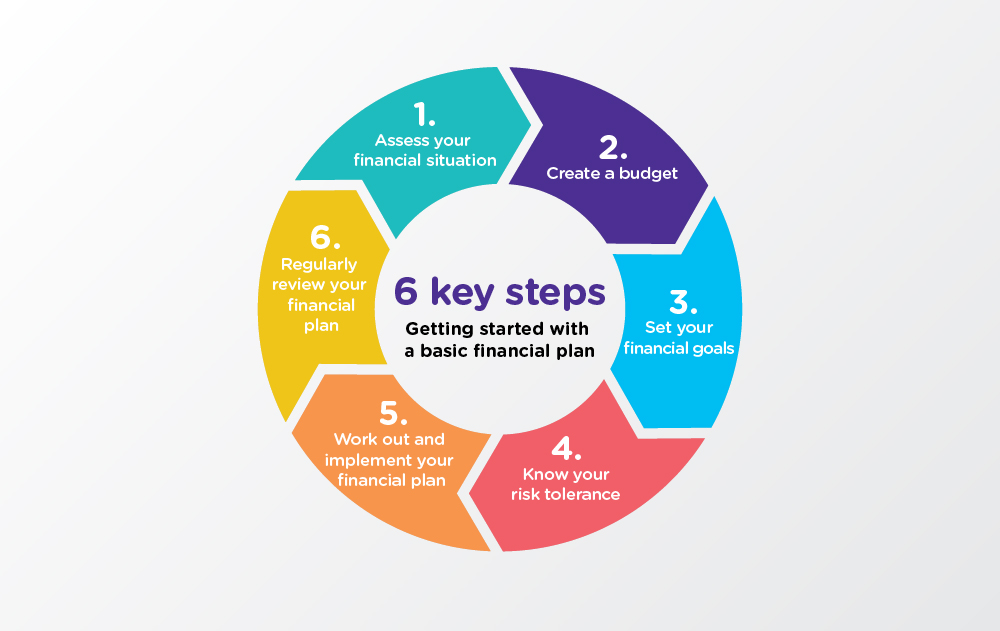Getting started
Financial planning is an ongoing process. It’s important you take the time to design a financial plan that works for your current situation, as well as to review it from time to time to ensure it meets your needs and financial goals. It involves six key steps to draw up a basic financial plan:

1. Assess your financial situation
A good first step when developing your financial plan is to assess your financial situation. With a clear understanding of your current financial situation, you can decide where you should start from, and what you need to achieve your financial goals.
Knowing your net worth is important to assessing your financial situation. Do this by making a list outlining all your assets (including your salary, bank savings, investments like shares or unit trusts, insurance products, including those which are bundled with investments or savings, endowment plans, etc); as well as your liabilities such as home loan, car loan and outstanding debts.
2. Create a budget
How much money is coming in and going out each week, fortnight or month? Track the ins (eg salary, pensions, benefits) and outs (including interest payments for mortgage repayment, other personal loans, cash advances, outstanding balance of credit card) of your money to understand your money habits and take control of your spending and savings.
Prioritise your needs and wants and look for any unnecessary expenses you can cut to save money. Also refrain from overspending especially impulse buying by credit card. Before you decide to borrow money, make sure you can afford new debt repayments on top of your current expenses or commitments.
Use our budget planner to record all of your incomings and outgoings which then add up your figures and gives a breakdown of where your spending goes each week, month or year across the following broad categories: household, transport, food and drinks, leisure, shopping, health and beauty, education and profession, family and friends, taxation, financial commitments, etc.
You have the option to save your budget planner results on your computer, print out and do it later, or you can set up a budget by downloading our budgeting spreadsheet into your computer.
3. Set your financial goals
Based on a sound understanding of your financial situation, you may be able to identify your short-, medium- and long-term financial goals. This will help you review your budget; and determine your investment time frame and a strategy for deciding on the appropriate investments. With measurable and clearly defined goals, it will be easier to monitor your progress.
It’s important to know what you are planning for. Make a list of all your needs and goals. Remember, manage day-to-day expenses should come first. Common financial goals can be going for vacation, buying a car, further education, getting married, buying a home, being debt-free or saving for retirement. The key thing is to set and prioritise realistic goals. For example, if you have borrowed money at a high interest rate (eg credit card advances or other personal loans), make paying off that debt your first priority before taking on other goals. You also need to map out the cost of each goal and how much time you have to save or invest before you need to pay for it (eg investment time horizon).
When setting your financial goals, it’s important to be realistic. As you regularly review and refine your financial plan and assess your risk tolerance level, you may find it worthwhile to adjust your goals accordingly.
Use our savings goal calculator to check how you can achieve your goals. It will help you work out how much you need to save each week, month and year in order to reach a savings goal, or if you plan to save a certain amount how long it will take for you to achieve your savings target.
4. Know your risk tolerance
Risk is the potential threat that may impact the expected outcome of your investments. Investments that deliver potentially higher returns are usually accompanied by higher risks. Are you willing to accept potential losses in exchange for greater potential gains?
An important part of your financial planning is to understand your tolerance for risks. When assessing your risk tolerance, you may wish to consider:
- Your financial goals and timeframes.
Allocating a timeframe to each investment goal will enable you to think about how much you can afford to invest and how long it will realistically take you to reach your goal. It’s important to know your investment timeframe and ask yourself if you can financially and psychologically cope with decline in the value of your investments. - Your personal profile.
This includes your stage of life, profession, source(s) of income, financial commitments, etc. If you’re young and single, for example, your risk tolerance will differ from a person with a family or approaching retirement. - How do you feel about putting your money at risk?
How would you feel if your investment balance dropped 20% overnight? If this drop would cause you to worry a lot and pull out of the investment, then a high-risk investment is not suitable for you because pulling out at the worst possible time may compound your losses. If you see such a drop as an opportunity for bargain buys, then you are probably more comfortable with market fluctuations and a higher level of investment risks.
Risk tolerance can be classified into five categories. Which one best describes you?
| Conservative | Not willing to take up risk and see loss in investment and may rather forgo potential gains. |
|---|---|
| Moderately cautious | May be willing to accept a limited amount of risks to improve their long-term investment returns, but still try to avoid large short-term fluctuations. |
| Balanced | Weighting the risks and returns, balanced investors recognise that taking on a measured amount of risks will improve the probability of achieving their long-term financial goals. |
| Moderately aggressive | By taking on greater investment risks, moderately aggressive investors expect to see their investment portfolio outperform the market; and do not mind accepting a bit more risk or loss than the market bears. |
| Aggressive | Ready to take on higher levels of risks in order to substantially outperform the markets. |
Once you understand your risk tolerance, you can start building an investment portfolio that will help you meet your financial goals.
5. Work out and implement a basic financial plan
Work out your basic financial plan with a feasible regular savings and investment target to meet your goals.
A holistic financial plan not only involves investing money and building your wealth; but also your credit and tax obligations, everyday spending, planning for wedding, setting up your home , saving for education fund for your children, saving for your retirement, as well as protection for you and your family through buying suitable insurance policies and conducting estate arrangement. All these facets of your financial plan are interconnected.
Here are some tips to help you put your basic plan together:
- Prioritise your needs and goals.
When it comes to financial planning, emergency savings and some health insurance and life insurance protection should come first rather than saving and investing for your retirement.
Many insurance products bundle protection coverage and investments or savings together. It’s important you are clear about your insurance needs. If you are the primary bread winner in your family, you should perhaps consider first the insurance product for the protection of your family instead of potential investment returns. - Identify action steps to reach your goals.
To save for emergencies for three to six months of living expenses, you might need to put aside more in savings or investments to achieve this. By starting earlier, your savings will benefit from the power of compounding effect to allow more time to grow your savings. If you are investing, a longer time frame allows you more time to ride out any short-term fluctuations. - Know the risks, understand your responsibilities and think before you invest.
Always remember to invest in products you fully understand and know. It’s your responsibility to exercise vigilance and due diligence to protect your interests. Don't invest in an area which carries higher risk than you are prepared to take. When investing, you should look at your investment objectives, risk tolerance and constraints, and plan accordingly. - Maintain a diversified portfolio of investments
When choosing a particular product for investing, find out whether it will complement the products you already have or expose you to more risks. Don't put all your eggs in one basket; diversification is a good way to mitigate risks. Monitor your investment portfolio regularly. You may need to rebalance your investments from time to time to ensure diversification of your investments.
6. Regularly review your plan
You should exercise strict discipline to follow the financial plan. Always review your existing budget from time to time to make sure it still works and review your financial plan regularly and adjust it when your resources, needs and situations change.




